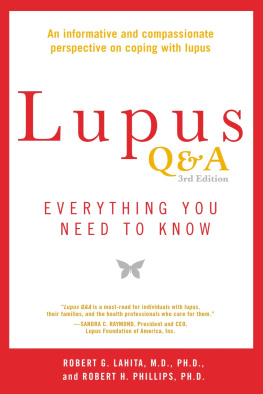OARL
OXFORD AMERICAN RHEUMATOLOGY LIBRARY

Lupus
This material is not intended to be, and should not be considered, a substitute for medical or other professional advice. Treatment for the conditions described in this material is highly dependent on the individual circumstances. While this material is designed to offer accurate information with respect to the subject matter covered and to be current as of the time it was written, research and knowledge about medical and health issues are constantly evolving, and dose schedules for medications are being revised continually, with new side effects recognized and accounted for regularly. Readers must therefore always check the product information and clinical procedures with the most up-to-date published product information and data sheets provided by the manufacturers and the most recent codes of conduct and safety regulation. Oxford University Press and the authors make no representations or warranties to readers, express or implied, as to the accuracy or completeness of this material, including without limitation that they make no representations or warranties as to the accuracy or efficacy of the drug dosages mentioned in the material. The authors and the publishers do not accept, and expressly disclaim, any responsibility for any liability, loss, or risk that may be claimed or incurred as a consequence of the use and/or application of any of the contents of this material.
OARL
OXFORD AMERICAN RHEUMATOLOGY LIBRARY

Lupus
The Essential
Clinicians Guide
2nd Edition
Daniel J. Wallace, MD, FACP, FACR
Executive Series Editor,
Oxford American Rheumatology Library
Clinical Professor of Medicine
Division of Rheumatology
Cedars-Sinai Medical Center
David Geffen School of Medicine at UCLA
Los Angeles, California


Oxford University Press is a department of the University of Oxford.
It furthers the Universitys objective of excellence in research, scholarship,
and education by publishing worldwide.
Oxford New York
Auckland Cape Town Dar es Salaam Hong Kong Karachi
Kuala Lumpur Madrid Melbourne Mexico City Nairobi
New Delhi Shanghai Taipei Toronto
With offices in
Argentina Austria Brazil Chile Czech Republic France Greece
Guatemala Hungary Italy Japan Poland Portugal Singapore
South Korea Switzerland Thailand Turkey Ukraine Vietnam
Oxford is a registered trademark of Oxford University Press
in the UK and certain other countries.
Published in the United States of America by
Oxford University Press
198 Madison Avenue, New York, NY 10016
Oxford University Press 2014
All rights reserved. No part of this publication may be reproduced, stored in a retrieval system, or transmitted, in any form or by any means, without the prior permission in writing of Oxford University Press, or as expressly permitted by law, by license, or under terms agreed with the appropriate reproduction rights organization. Inquiries concerning reproduction outside the scope of the above should be sent to the Rights Department, Oxford University Press, at the address above.
You must not circulate this work in any other form
and you must impose this same condition on any acquirer.
Library of Congress Cataloging-in-Publication Data
Wallace, Daniel J. (Daniel Jeffrey), 1949 author.
Lupus: the essential clinicians guide/Daniel J. Wallace.2nd edition.
p.; cm.(Oxford American rheumatology library)
Includes bibliographical references and index.
ISBN 978-0-19-936196-0 (alk. paper)
I. Title. II. Series: Oxford American rheumatology library.
[DNLM: 1. Lupus Erythematosus, Systemic. WD 380]
RC312.5.S5
616.772dc23
2013031123
9 8 7 6 5 4 3 2 1
Printed in the United States of America
on acid-free paper
Contents
Chapter 1
The History of Lupus
Lupus (meaning wolf in Latin) was a Roman family name, and there was a St. Lupus who lived in central France in about A.D. 600. Moritz Kaposi (for whom Kaposis sarcoma is named) first used the description discoid to describe cutaneous lupus in the 1860s.
Credit for describing disseminated, or systemic, lupus and connecting its rashes with organ involvement goes to Sir William Osler (18491919), who initially described our current concepts of the clinical aspects of the disease in three long articles published between 1872 and 1895. Between 1900 and 1950, pathological descriptions of cardiac, pulmonary, and central nervous system involvement increased our general knowledge.
In 1941, Paul Klemperer coined the term collagen vascular disorders to apply to a group of what are now known to be autoimmune conditions. This led to initiatives to classify this family of disorders. The first criteria for systemic lupus erythematosus (SLE) were published in 1971, followed by revisions in 1981 and 1997, and a new classification in 2012. Other related variants of lupus, such as drug-induced lupus (1945), neonatal lupus (which is not actually lupus), overlap syndromes, mixed connective tissue disease, antiphospholipid syndrome (1983), and incomplete forms of lupus-like inflammation (undifferentiated connective tissue disease), followed. By the late 1970s, a nosological compilation of cutaneous manifestations of lupus was put together by James Gilliam.
Although a few cases of false-positive syphilis serologies were reported as early as 1909 in lupus patients, and hypergammaglobulinemia associated with lupus in 1943, the single major advance in identifying lupus by blood testing was published in 1949. Malcolm Hargraves, a hematologist at the Mayo Clinic, found globular antibodies taking purple stain in the marrow aspirate of a child with undiagnosed disease. The discovery of the LE cell greatly advanced the field, as it became possible for the first time for a blood test to be used to diagnose lupus, and biopsies were no longer mandatory. The LE cell turned out to be a DNA-histone nucleoprotein. Efforts to improve identification of protein markers in lupus resulted in antinuclear antibody and anti-DNA testing becoming available in the late 1950s. (Advances are summarized in .) Insights into the role of complement in inflammation and advances in immune techniques allowed anti-Sm, anti-RNP, anti-ENA, anti-Ro (SSA), and anti-La (SSB) to be identified and elucidated in the 1960s.

Figure 1.1 The first modern illustration of cutaneous lupus, labeled lupus erythemateux (1856). Source: Wallace DJ, Lyon I. Pierre Cazenave and the first detailed modern description of lupus erythemotosus. Semin Arthritis Rheum. 1999;28:305313. Reprinted with permission, Elsevier, 1999.
Table 1.1 First descriptions of components of lupus
Description | Year | Author |
Butterfly rash | 1845 |
Next page












